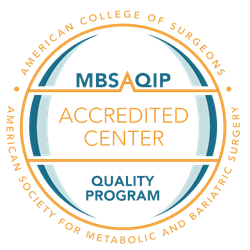 Adjustable gastric banding (LAP-BAND®)
Adjustable gastric banding (LAP-BAND®) is a safe and effective surgical solution for the treatment of morbid obesity. In the United States the
LAP-BAND® was approved by the FDA in June 2001. Gastric banding has been successfully used in Europe and Australia for over 15 years with over 600,000 bands placed worldwide.
Gastric banding is a restrictive weight loss procedure that involves placing an adjustable silicone band around the upper stomach to create a small pouch that will hold only a small amount of food at any one time. Food will progress from the small pouch to the rest of the stomach slowly because of the narrowing created by the band. As a result, patients fell full sooner and stay full longer. The surgeons at Christiana Institute of Advanced Surgery perform this procedure using minimally invasive techniques. This operation is usually an outpatient procedure and patients are typically back to work within several days.
The size of the narrowing created by the gastric band can be adjusted to fit the patient’s needs from the outside without further surgery. The band is attached by thin tubing to an access port placed beneath the skin. The port can be used to change the tightness of the band. If weight loss is too slow, the band can be tightened. If you are having difficulties with eating solid food or become pregnant and need to eat more, the band can be loosened.
Adjustable Gastric Banding (LAP-BAND AP® System) Surgery Results
The amount of weight each patient will lose depends on multiple factors including your genetic makeup, activity level, choice of operation and numerous other factors.
Most gastric band patients lose 45 to 55% of their excess body weight and keep it off over the long-term. Keep in mind that your surgery is only a tool to help you lose weight. Patients who adhere to a healthy diet and exercise routine frequently can reach a weight close to their ideal body weight and maintain it. Those that only rely on surgery and do not change their behavior and become more active will not have the same result.
In addition to significant weight loss, there are health and quality of life benefits to having adjustable gastric banding surgery:
- There is no cutting or stapling of the stomach, and the risk of malnutrition is low.
- The band allows for individualized weight loss rate and supports pregnancy because the narrow opening can be made larger for increased nutrition.
- Although intended as a long-term treatment, the band can be removed at any time, in some cases laparoscopically.
- Studies found that gastric banding resolved type 2 diabetes in 47.8 % of patients, resolved high blood pressure in 38.4% of patients, and � improved high cholesterol in 78.3% of patients.*
- It also improves the overall quality of life, physical functioning, and social and economic opportunities.
Potential Patient Concerns
- Although the rate of these complications is low, the unique complications associated with the band include erosion into the stomach and slippage of the band.
- To achieve success, patients need to follow specific diet and exercise guidelines provided by your surgeon, because the band does not eliminate the desire to eat.
- Patients must commit to follow-up visits more so than with other bariatric procedures. Some of these visits will include band �adjustments to make the narrowing smaller or larger. Even after reaching and maintaining goal weight, patients may still need to see their surgeons for further follow up.
*Buchwald H, Avidor Y, Braunwald E, et al. Bariatric Surgery: A Systematic Review and Meta-Analysis. JAMA 2004;292(14):1724-37.
